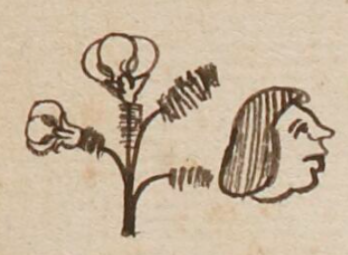Xochicuauh (Verg10r)
This black-and-white drawing of the compound glyph for the personal name Xochicuauh ("Flower-Tree," attested here as a man's name), shows a frontal view of a plant with two flowers (xochitl) on stems to the left and two stems on the right that have amaranth (huauhtli) blossoms. The amaranth may be literal, or the huauhtli may be a phonetic complement for the -cuauh part of the name (intending cuahuitl, tree, or cuauhtli, eagle). See below for an example of huauhtli providing the phonetic -huauh in the name Tecihuauh.
Stephanie Wood
Visuals of huauhtli can also serve as the phonetic syllable -hua. But, if that were the case here, the gloss would be something more like Xochhua. See below for examples of Xochhua.
Stephanie Wood
damiā. xochicuauh
Damián Xochicuauh
Stephanie Wood
1539
flowers, flores, amaranth, amaranto, trees, árboles, wood, madera, eagles, águilas, nombres de hombres

xochi(tl), flower, https://nahuatl.wired-humanities.org/content/xochitl
huauh(tli), amaranth, https://nahuatl.wired-humanities.org/content/huauhtli
Flores-Árbol
Stephanie Wood
Codex Vergara, folio 10r, https://gallica.bnf.fr/ark:/12148/btv1b84528032/f27.item.zoom
The non-commercial reuse of images from the Bibliothèque nationale de France is free as long as the user is in compliance with the legislation in force and provides the citation: “Source gallica.bnf.fr / Bibliothèque nationale de France” or “Source gallica.bnf.fr / BnF.” We would also appreciate a citation to the Visual Lexicon of Aztec Hieroglyphs, https://aztecglyphs.wired-humanities.org/.Codex Vergara, folio 12r,




